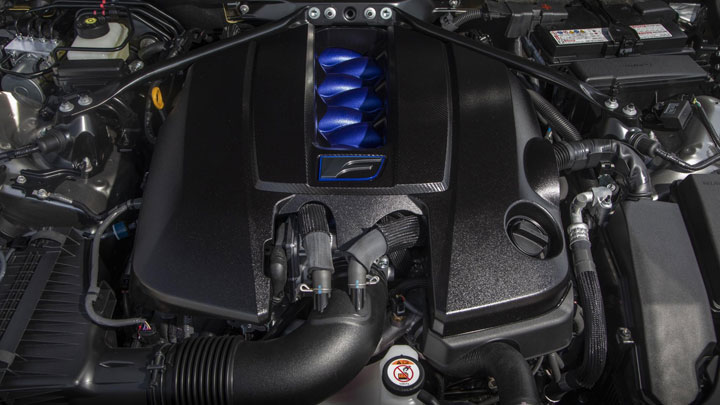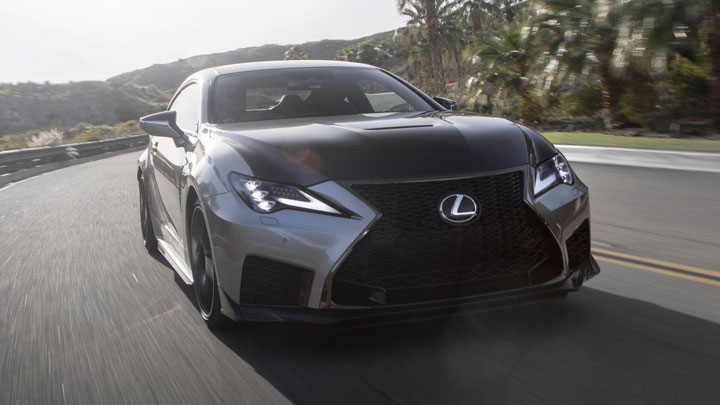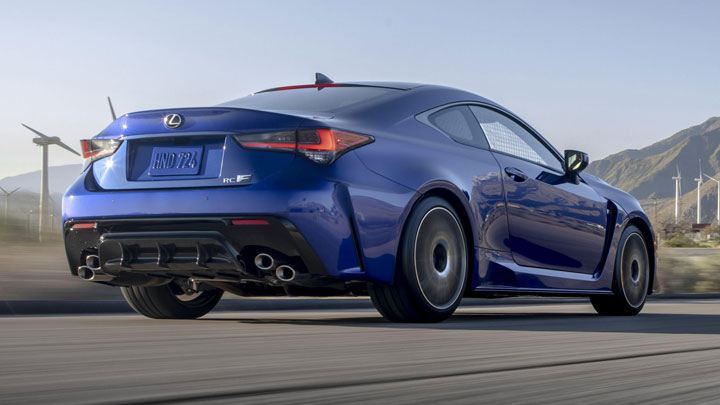What is it?
The current generation Lexus RC F Coupe has lots to like—it’s growling 5.0-liter naturally aspirated V8 and extraordinary build quality—but also two main failings: too much weight that’s also too far forward. This can cause chronic understeer when pushing on which overworks the brakes and tires, especially when using all the power on track.
These issues were created when, instead of building a new platform, the company fused what it considered the best bits from three existing models: the GS sedan at the front, the IS convertible for the mid section, and the IS sedan at the rear. It made a fine, if heavy, road car. But there was always going to be issues to resolve on the circuit.

The good news is that the 2020 model year RC F is both lighter (25kg) and a smidge (5hp) more powerful at 472hp. So that’s two steps in the right direction. But the even better news is that this year there’s a special Track Edition version of the RC F. This has been designed to show that Lexus is still serious about its F models having proper track performance.
While having the same engine output as the regular RC F, the TE model shaves another 54kg of weight out of the car, for a total loss of 80kg. A lot of that coming from unsprung mass like wheels and brakes. Weight paring isn’t just about reduction but location. The further away from the center of gravity the more it matters. Hence the car also wears a carbon fiber hood, roof, trunk lid, and wing.

Other key weight savers include a titanium exhaust and a carbon cabin cross brace. But if you look at the detail of the car, pretty much every component has been studied microscopically, reassessed and subtly re-engineered to be lighter, stronger, better. And, on paper at least, it’s worked. The TE is a couple of average humans lighter than the AMG C63 S Coupe even if it is still a passenger heavier than the BMW M4.
While the standard RC F uses an optional torque-vectoring differential, the TE employs a muscle car-style Torsen limited slip setup to keep the right pedal as closely connected as possible to the actions of the rear tires. To also help precise throttle position, the rear drive ratio has been changed from 2.97:1 to 3.13: 1. You might expect the TE to wear some serious track rubber—we did—but Lexus has fitted all versions with the same Michelin Pilot Sport 4S tires to preserve on-street manners. TE owners might want to try a set of Cup 2s.
At least they might once they’ve saved up again after buying the car. While the standard RC F costs $65,775 (P3.4 million) the Track Edition is quite a long walk away at $97,675 (P5 million).
What is it like on the road?
Half a lap into driving the TE, it’s clear that this is the car we always wanted the RC F to be. The understeer is not gone completely but you can now steer the car on the throttle at will instead of having to bung it into corners. The naturally aspirated V8 might lack a bit of the turbo and supercharged competition’s grunt out of corners, but the way you can now so finely meter the throttle lets you get on it earlier and harder, so you can perfectly control the TE’s attitude.

RC F Chief Engineer Yuuichi Tsurumoto says throttle steering was the key attribute he wanted to dial into the RC F chassis, and he has delivered with the TE. The standard RC F, while some way from being as much fun as its more extreme sibling, is still markedly improved over the model it is replacing. It doesn’t share the TE’s hooligan-style diagonal corner exits, preferring to round off the edges of response on the limit. But it’s still more fun to throw around.
We didn’t get a huge amount of time to assess the TEs carbon brakes on track, but after several sets of three-lap sessions there was very little degradation in the stopping performance. So all we can report is that they didn’t fade throughout and had enough feel and power to slow and blend smoothly into Thermal Raceway’s apexes.
This choice of racetrack was a brave one for a car that has traditionally suffered from weight and understeer issues. With sequences of late apexes it highlights every pound of extra weight and every degree of steering that doesn’t send the car in the right direction. Once set up for the corner, the TE had a benign linearity to its actions, allowing you to tighten and widen at will using the throttle. That’s real progress.
But none of this is at the expense of road manners and performance in the TE. The multi-modal engine and chassis management system allows you to turn the savage-sounding track beast into a calm cruiser. The ride stays calm, composed and subtle. The fine, linear, predictable responses still there, just buried a layer or two down. You could go comfortably on a long tour in this car and never know about its weapons-grade performance ability.
What’s it like on the inside?
You can’t mistake the RC F’s interior for anything other than a Lexus. There’s the electronic scratch pad, a CD Player, and a host of other touches that remind you you’re in a Japanese sports car. You can love or loathe them, but you can’t argue with the otherworldly quality of their execution. It’s way above anything most of the Germans or Brits can offer.

And there won’t be any mistaking that you are in an RC F TE. Instead of the usual blacks, browns and grays of the range, the cabin is covered in Flare Red leather and Alcantara, the floor in a matching red carpet. The seats in the TE, which are dished enough to keep you located on the track but comfortable enough for a long road trip, are not heated and cooled, to save weight. But otherwise there is every luxury you’d expect in a Lexus—including a 17-speaker sound system.
The rear seats should probably have been a delete option on the TE—and the standard RC F. They really are not designed to carry anything human. Much better to just admit it’s extra space for gear and shopping and have done with it.













